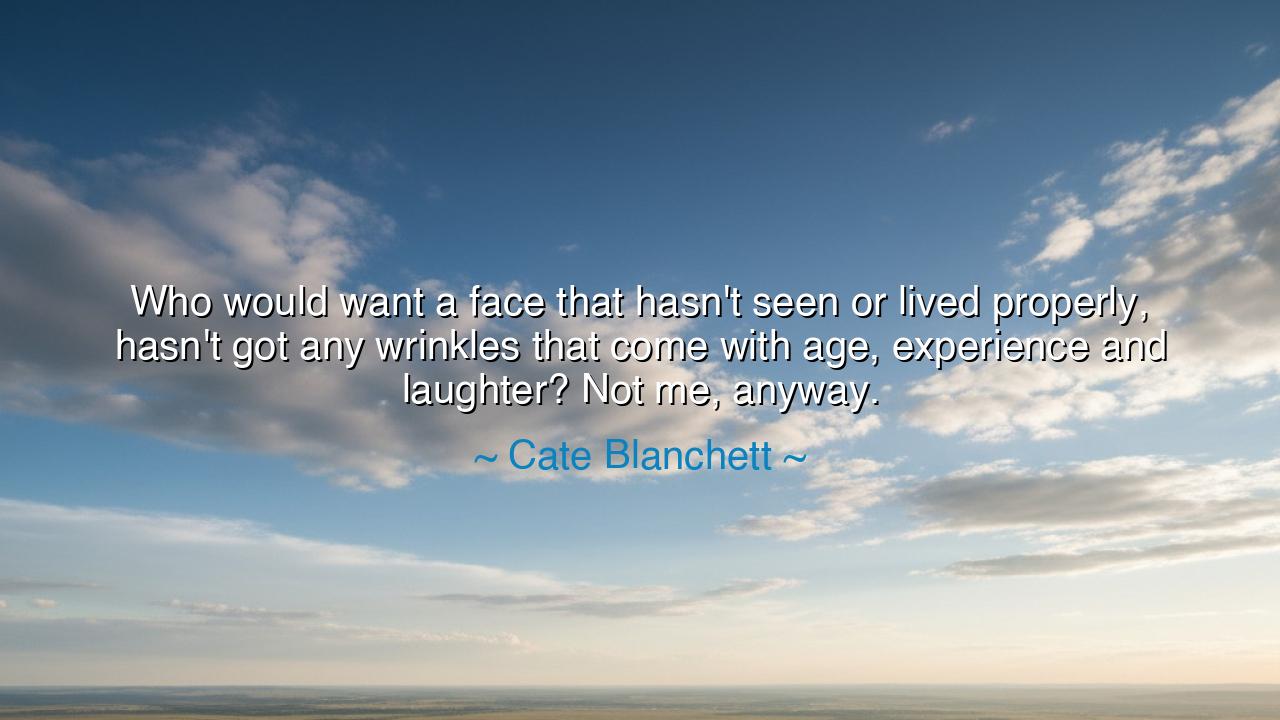
Who would want a face that hasn't seen or lived properly, hasn't
Who would want a face that hasn't seen or lived properly, hasn't got any wrinkles that come with age, experience and laughter? Not me, anyway.






In the words of Cate Blanchett, “Who would want a face that hasn’t seen or lived properly, hasn’t got any wrinkles that come with age, experience, and laughter? Not me, anyway.” These words shine like a mirror to the human soul, reflecting a truth that has been known since the dawn of time but often forgotten in our pursuit of perfection: that beauty is not in smoothness, but in story. Blanchett, one of the most respected actors of her generation, speaks here not merely of the face, but of the life behind it—the face as a living testament to all we have endured, loved, and become. She rejects the false idols of vanity and worships instead the holiness of authenticity, the sacred mark of a life fully lived.
In the ancient world, the wise saw wrinkles as a crown, not a curse. The Greeks revered age as the companion of wisdom, and in many Eastern traditions, the elders were considered living scriptures, their faces the pages upon which time had written truth. A face untouched by experience, Blanchett reminds us, is like a blank page—flawless, perhaps, but empty. To live properly is to let the seasons of the soul etch themselves upon you—to bear the lines of laughter, the creases of grief, the traces of countless sunrises and storms. These are not flaws; they are the signatures of existence itself.
Blanchett’s words stand in defiance of an age obsessed with youth and illusion, where smoothness is prized above substance and where the fear of aging has become a silent epidemic. Yet she reminds us that what fades in flesh deepens in spirit. Every wrinkle, every line, is a mark of participation in life’s great drama. The laughter that once made the eyes sparkle leaves behind a gentle trace, as if joy refused to depart completely. The sorrow that carved its lines into the brow transforms into depth, empathy, and quiet strength. To erase these is to erase one’s story—to erase proof that we have felt deeply and lived truly.
Think of Eleanor Roosevelt, whose face, lined with care and compassion, became an emblem of courage and conviction. She once said, “Beautiful young people are accidents of nature, but beautiful old people are works of art.” Her countenance was not conventionally beautiful, but it radiated a strength that could not be feigned. Every wrinkle spoke of struggle and triumph, of a woman who faced war, prejudice, and personal sorrow, yet never lost her dignity or hope. Such beauty cannot be manufactured—it must be earned through life itself.
To desire a face without wrinkles, Blanchett implies, is to desire a life without growth. A smooth face may please the eye for a moment, but it does not move the heart. The heart is stirred by evidence of humanity—by imperfection, by survival, by resilience. For what is the value of eternal youth if it comes at the cost of authenticity? What is the worth of unblemished skin if it hides a spirit that has never dared, never laughed until it wept, never suffered and risen again? True beauty is not in the absence of age, but in the presence of truth.
The lesson, then, is this: embrace the passage of time as your greatest sculptor. Let your face tell its story without shame or concealment. The lines that come with age are not marks of decline, but of fulfillment—they are the poetry of a life that has dared to live fully. When you see your reflection, do not mourn what is lost; honor what has been gained. Wear your age as the armor of the soul, each mark a testament that you have lived, loved, and learned.
So, my child, reject the lie that youth is the only form of beauty. Seek instead the beauty that endures—the beauty of character, of kindness, of courage. Do not smooth away your story; let it shine. For when all else fades, it is the face that has known joy and sorrow, laughter and loss, that will glow with the light of eternity. As Blanchett’s words remind us, the truest face is not the untouched one—it is the face that has lived.






AAdministratorAdministrator
Welcome, honored guests. Please leave a comment, we will respond soon